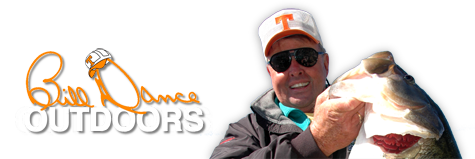Worm Presentations, Oiling Reels and Lipless CranksPosted: October 9th, 2013 by Bill Dance Q. When bass aren’t responding to your bottom-bumping presentation with a jig, worm, lizard, grub or tube bait is there any techniques you use to trigger a strike? A. Yes, when you try to impart too much action to the lure with your rod tip can be a turn-off. Instead of jerking the rod tip repeatedly and making the lure dance like a teenager at a sock-hop, try holding the rod steady at about 10 o’clock position and use only the reel handle to move the lure. Naturally if the lure makes contact with cover, you’ll need to flip the rod-tip gently to hop the bait over and through it. I’ve seen this presentation work, more times than I can count, especially when bass were in a non-aggressive stage. Q. How often do you oil your reels, and what weight oil do you recommend? A. Well, not as often as I should. Reels tend to be one of the more neglected items of tackle. Reels aren’t cheap and should be well cared for. Naturally, depending on how much they’re used, I try to clean and oil my reels every month, with a quality, light-weight oil. One drop of oil on bearings and other necessary moving parts is plenty. The key is applying it at regular intervals. What you don’t do is add clean oil to dirty oil–that will compound the problem. Q. What’s the average length of a one-year-old largemouth bass? A. Believe it or not, it can vary from about 2-8 inches. They can reach 9-10 inches in the second year, but it’s usually in the third year. Naturally this depends on location and the type and amount of forage. During the first three years, a bass really doesn’t grow all that fast, but during the third year, their weight and length really take off, especially in warm water climate. Naturally, there are some exceptions. Q. How long does it take for a bass to digest its food? A. Bass usually require at least 12 hours to digest their food under the best conditions. Since digestion is a chemical process, the rate of the process is a function of body temperature. Naturally, in winter, digestion is slowest and in the summer it’s faster. Example: normally, when the water temperatures range from 70-80 degrees, bass digest the food in their stomach in about 18 hours. But in the winter, the same bass would take four days or longer to digest their food. Q. Don’t you think most lipless crank baits have poor-hooking ability? A. The basic design of these baits works in favor of acrobatic bass, simply because the weight of the flat sides provide enough leverage to work the treble hooks free on many occasions. To remedy this situation and help prevent the biggest danger of a bass dislodging the lure when it takes flight, immediately poke your rod-tip a couple of feet below the surface once a fish is hooked. Although, this won’t always be enough to stop the initial jump, you’ll usually be able to keep the fish from making additional jumps and this will work in your favor. As always, catch one for me!
|
Upload your trophy bass photo (or any other fish) to BillDanceOutdoors.com! Or, post comments about other photos submitted by Bill Dance fans.
Bill Dance is one of the most recognizable names and brands in fishing and outdoor gear. Please browse through our selection of superior products that proudly carry the Bill Dance name.
|





